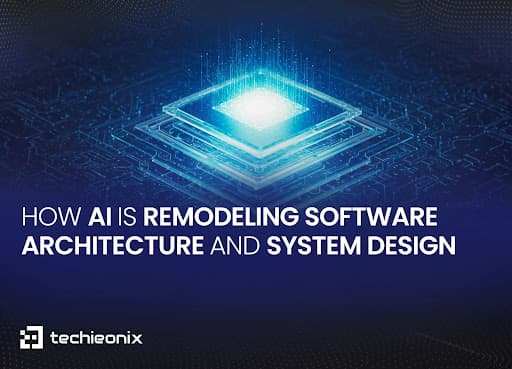Software architecture is the backbone of every modern application. However, with growing complexity, global scalability demands, and real-time user expectations, traditional approaches are reaching their limits.
This is where Artificial Intelligence (AI) steps in, not just as a tool for end-user applications, but as a co-creator of system design. From predictive scaling to automated code generation, AI is revolutionizing how we approach architecture.
The Evolution from Traditional to AI-Powered Architecture
Traditional software architecture has long relied on human expertise to make critical decisions about system design, component interaction, and resource allocation. Architects would analyze requirements, design systems based on established patterns, and manually optimize for performance, scalability, and reliability. While this approach has produced countless successful systems, it has inherent limitations in handling the complexity and scale demands of modern applications.
Limitations of Traditional Approaches: Traditional architectural approaches struggle with several key challenges. The complexity of modern distributed systems often exceeds human cognitive capacity to fully understand and optimize. Manual optimization processes are time-consuming and often suboptimal, particularly when dealing with dynamic workloads and changing requirements. Static architectures cannot adapt to real-time conditions, leading to over-provisioning, performance bottlenecks, and inefficient resource utilization.
The AI-Powered Paradigm Shift: AI-powered software architecture introduces intelligent automation throughout the system lifecycle. Instead of static designs, we now have adaptive architectures that evolve based on real-time data and changing conditions. Machine learning algorithms can analyze vast amounts of system telemetry to identify optimization opportunities that human architects might miss. This shift represents more than technological advancement—it's a fundamental change in how we think about system design.
Core AI Technologies Transforming Architecture
Machine Learning for System Optimization
Machine learning algorithms are revolutionizing how systems optimize themselves for performance, cost, and reliability. These algorithms can analyze historical performance data, user behavior patterns, and resource utilization metrics to make intelligent decisions about system configuration and resource allocation.
Predictive Scaling and Resource Management: ML models can predict traffic patterns, resource demands, and system bottlenecks with remarkable accuracy. This enables proactive scaling decisions that maintain performance while minimizing costs. Netflix uses machine learning to predict viewership patterns and pre-scale their content delivery infrastructure across global regions.
Intelligent Load Balancing: Traditional load balancers distribute traffic based on simple algorithms, such as round-robin or least connections. AI-powered load balancers consider multiple factors, including server health, response times, geographic proximity, and even the complexity of requests to make optimal routing decisions in real-time.
Performance Anomaly Detection: Machine learning models excel at identifying subtle patterns that indicate emerging performance issues. These systems can detect anomalies in response times, error rates, or resource consumption patterns that might indicate underlying problems before they impact users.
Natural Language Processing in Architecture Design
NLP technologies are bridging the gap between business requirements and technical implementation, enabling more intuitive and accessible architecture design processes.
Requirements to Architecture Translation: Advanced NLP systems can analyze business requirements written in natural language and suggest appropriate architectural patterns, technologies, and design decisions. This capability democratizes architecture design and helps ensure alignment between business needs and technical implementation.
Intelligent Documentation Generation: AI systems can automatically generate and maintain architectural documentation by analyzing code structure, deployment configurations, and system behavior. This addresses one of the most challenging aspects of software architecture, keeping documentation current and accurate.
Code Generation and Architecture Implementation: Tools like GitHub Copilot and Amazon CodeWhisperer are evolving to generate not just individual functions but entire architectural components. These systems can create boilerplate code for common architectural patterns and implement standard integrations.
Revolutionary Architectural Patterns Enabled by AI
Self-Healing Systems
Self-healing architectures represent one of the most compelling applications of AI in system design. These systems can automatically detect, diagnose, and resolve issues without human intervention.
Automated Incident Response: AI-powered systems can correlate multiple signals, error rates, performance metrics, user complaints, and system logs, to automatically identify the root cause of issues and execute appropriate remediation actions. This might include restarting failed services, scaling resources, rerouting traffic, or even rolling back problematic deployments.
Predictive Maintenance: Machine learning models can analyze system health metrics to predict when components are likely to fail, enabling proactive maintenance that prevents downtime rather than reacting to failures after they occur.
Adaptive Microservices Architectures
Microservices architectures benefit significantly from AI-powered intelligence that can dynamically optimize service boundaries, communication patterns, and resource allocation.
Dynamic Service Boundaries: AI systems can analyze service communication patterns, data flow, and performance characteristics to suggest optimal service boundaries. As systems evolve, these algorithms can recommend when to split services that have grown too complex or merge services that are tightly coupled.
Intelligent Service Mesh Management: Service meshes like Istio and Linkerd are incorporating AI capabilities to automatically optimize routing decisions, implement intelligent retry policies, and manage security policies based on observed traffic patterns and threat detection.
Auto-Scaling with Context Awareness: Traditional auto-scaling relies on simple metrics, such as CPU or memory utilization. AI-powered auto-scaling considers multiple factors including user behavior patterns, seasonal trends, business events, and even external factors that might impact traffic.
Cognitive Data Architectures
Data architectures are being transformed by AI capabilities that can automatically understand, organize, and optimize data flows.
Intelligent Data Pipelines: AI systems can monitor data quality, detect schema changes, and automatically adjust data processing pipelines to maintain data integrity and performance. These systems can also identify optimization opportunities in data transformations and suggest more efficient processing approaches.
Automated Data Discovery and Cataloging: Machine learning algorithms can automatically discover, classify, and catalog data assets across an organization, making it easier to find and utilize relevant data while ensuring compliance with privacy and governance requirements.
Practical Implementation Strategies
Getting Started with AI-Powered Architecture
Assessment and Planning: Begin by conducting a comprehensive assessment of your current architecture to identify areas where AI could provide the most value. Look for repetitive operational tasks, performance optimization challenges, and areas where human decision-making is a bottleneck.
Focus on use cases with clear, measurable outcomes such as cost reduction, performance improvement, or operational efficiency gains. Start with pilot projects that have limited scope and risk but can demonstrate clear value.
Building AI-Ready Infrastructure: Implement comprehensive monitoring and telemetry collection to provide the data foundation that AI systems need. Ensure your infrastructure can capture detailed metrics about system performance, user behavior, and operational events.
Adopt cloud-native technologies and containerization to provide the flexibility and scalability needed for AI-powered optimization. Implement Infrastructure as Code practices to enable automated provisioning and configuration management.
Incremental Adoption Approaches
Phase 1: Monitoring and Analytics: Start by implementing AI-powered monitoring and analytics to gain insights into system behavior and performance patterns. Use machine learning for anomaly detection and performance optimization recommendations.
Phase 2: Automated Operations: Gradually introduce automation for routine operational tasks such as scaling, deployment, and basic incident response. Implement self-healing capabilities for common failure scenarios.
Phase 3: Intelligent Optimization: Deploy more sophisticated AI systems for resource optimization, traffic management, and predictive maintenance. Begin experimenting with adaptive architectures that can modify their behavior based on changing conditions.
Challenges and Considerations
Technical Challenges
Model Drift and Reliability: AI models can degrade over time as the underlying data patterns change, leading to poor decisions that can impact system performance or stability. Implement continuous monitoring and retraining pipelines to maintain model accuracy and reliability.
Complexity and Debugging: AI-powered systems can be more difficult to debug and troubleshoot when issues arise. The decision-making process may not be transparent, making it challenging to understand why the system behaved in a particular way.
Organizational Challenges
Skills and Expertise: Implementing AI-powered architecture requires specialized skills in both traditional software architecture and machine learning. Organizations may need to invest in training existing staff or hiring new talent with the required expertise.
Cultural Resistance: Teams may be resistant to adopting AI-powered systems, particularly if they're concerned about job displacement or loss of control. Address these concerns through education, training, and gradual adoption approaches.
Future Trends and Emerging Technologies
The future promises even more sophisticated AI-powered architecture capabilities. Quantum computing will significantly accelerate certain types of AI computations, particularly optimization problems that are central to system architecture decisions. Edge AI and distributed intelligence will enable more resilient systems that can operate effectively even when connectivity to central systems is limited.
The ultimate goal is fully autonomous infrastructure that can design, deploy, and manage itself with minimal human intervention. This includes systems that can automatically provision new resources, adjust architectural patterns based on changing requirements, and even rewrite their own code to optimize performance.
Ready to future-proof your architecture?
At Techieonix, we help businesses design AI-driven, adaptive systems that scale intelligently and optimize themselves in real time.
Let’s build smarter software together.
Let’s DiscussClosing Thoughts
AI-powered software architecture represents a fundamental shift in how we design, build, and operate software systems. The convergence of artificial intelligence with traditional architectural practices is creating unprecedented opportunities for building more intelligent, adaptive, and efficient systems.
Early adopters are already reaping significant benefits, including reduced operational overhead, improved system performance, faster deployment cycles, and enhanced reliability. As AI technologies continue to mature, organizations that fail to embrace these capabilities risk being left behind by more agile competitors.
The journey requires careful planning, gradual implementation, and continuous learning. Success depends not just on technical expertise but also on organizational readiness and strategic alignment with business objectives. The future of software architecture is intelligent, adaptive, and autonomous, and that future is arriving faster than many realize.
AI-powered architecture isn’t just the next step—it’s the new standard. By combining intelligence with design, organizations can achieve systems that learn, adapt, and evolve with changing demands. The future of software is autonomous—make sure your architecture is ready for it.

